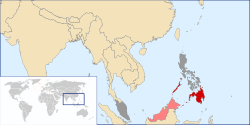This article may rely excessively on sources too closely associated with the subject , potentially preventing the article from being verifiable and neutral.(October 2015) |
United Federated States of Bangsamoro Republik | |||||||||
|---|---|---|---|---|---|---|---|---|---|
| 2013 | |||||||||
Flag | |||||||||
 Maximum area claimed by the Bangsamoro Republik | |||||||||
| Status | Unrecognized state | ||||||||
| Capital | Davao City [1] (de jure) Zamboanga City (de facto) | ||||||||
| Largest city | Davao City | ||||||||
| Demonym | Bangsamoro | ||||||||
| Government | Federal presidential constitutional republic [2] | ||||||||
| President | |||||||||
• 2013 | Nur Misuari | ||||||||
| Independence from the Philippines | |||||||||
| History | |||||||||
• Declared | July 27, 2013 | ||||||||
• Defeated in Zamboanga | September 28, 2013 | ||||||||
| Area | |||||||||
• Total | 115,971.03 km2 (44,776.67 sq mi) [a] | ||||||||
| Time zone | UTC+8 | ||||||||
| |||||||||
The Bangsamoro Republik, officially the United Federated States of Bangsamoro Republik (UFSBR), [3] was a short-lived, self-proclaimed, unrecognized breakaway state in the Philippines. Nur Misuari, chairman of the Moro National Liberation Front, issued the Proclamation of Bangsamoro Independence on July 27, 2013 in Talipao, Sulu and declared the capital of Bangsamoro to be Davao City. [4]
